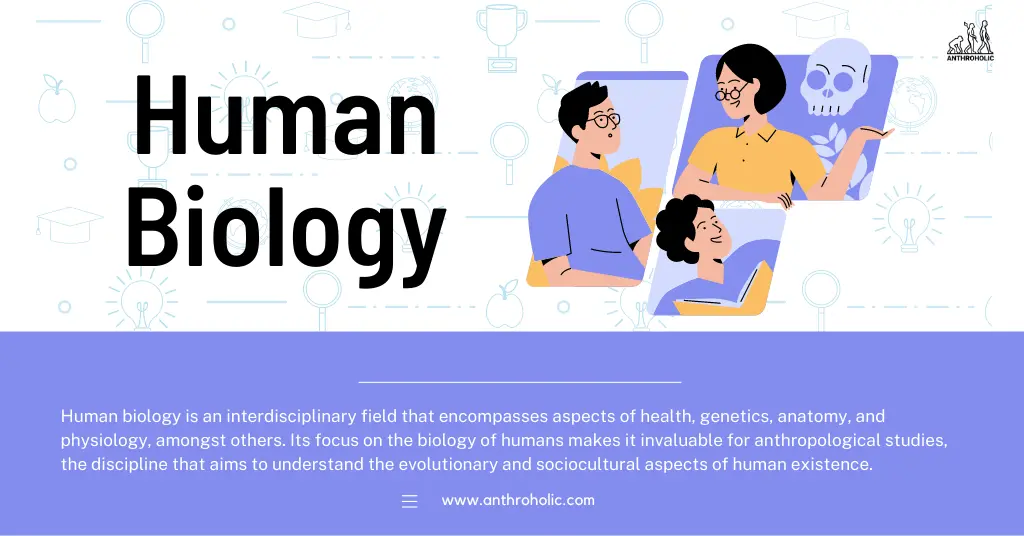AI Answer Evaluation Platform Live Now. Try Free Answer Evaluation Now
Human Biology
Human biology is an interdisciplinary field that encompasses aspects of health, genetics, anatomy, and physiology, amongst others. Its focus on the biology of humans makes it invaluable for anthropological studies, the discipline that aims to understand the evolutionary and sociocultural aspects of human existence. This article will delve into the role of human biology in anthropology, exploring various elements that aid in our understanding of humankind.

The Intersection of Human Biology and Anthropology
Biological Anthropology
Biological anthropology, also known as physical anthropology, forms one of the four primary fields of anthropology and is heavily reliant on human biology. It deals with the biological and behavioral aspects of human beings, their related non-human primates and their extinct hominin ancestors. Some key components include:
- Human evolution and variability.
- Primatology: the study of non-human primates.
- Human osteology and skeletal biology.
- Human behavior and ecology.
- Population genetics and evolution.
Understanding Human Evolution
Studying human evolution is a significant area where human biology interfaces with anthropology. It aids in understanding how humans have evolved over millions of years and how they have adapted to their environment biologically and culturally. Tools used include:
- Fossil records: They provide crucial evidence about extinct hominins, their physical characteristics, and adaptations.
- Genetics: Modern technologies such as next-generation sequencing enable the exploration of human and hominin genomes, revealing evolutionary relationships and traits.
The Significance of Human Biology in Anthropological Research
Human biology holds immense importance in anthropological research, offering vital insights into the human experience.
Understanding Human Diversity
Human biology is critical to understanding human diversity. It reveals how biological and genetic factors influence human behavior and capabilities, thus providing an essential context for anthropological studies.
- Genetic Variation: Studying genetic diversity helps us understand human migration patterns, population differentiation, and cultural implications.
- Physiological Adaptation: The study of adaptations to different environments (high altitudes, extreme temperatures) helps understand human survival mechanisms.
Health and Disease in Anthropology
Human biology aids in understanding health and disease within cultural and historical contexts.
- Evolutionary Medicine: It studies how evolution has shaped disease susceptibility and response to treatment.
- Bioarcheology: The study of skeletal remains can provide insights into the health, disease, and nutrition of past populations.
Growth, Development, and Aging
The human life cycle and its various stages are integral to anthropological studies.
- Growth and Development: The study of human growth patterns and developmental stages helps understand the biological and environmental factors that influence them.
- Aging: Human biology helps examine the biological, social, and cultural aspects of aging.
Application of Human Biology in Anthropology
The application of human biology in anthropology can be seen in several key areas:
- Forensic Anthropology: This involves identifying human remains and determining their age, sex, stature, ancestry, and possible cause of death.
- Nutritional Anthropology: This studies the relationship between diet, culture, and evolution.
- Biocultural Anthropology: This examines the interaction between biology and culture, and how they influence human health and well-being.
Evolutionary Perspective and Human Adaptability
An evolutionary perspective, which is central to both human biology and anthropology, enables us to understand the biological adaptability of humans.
- Physical Adaptations: These include changes in skin color, body size, and metabolic rate in response to environmental stresses like temperature, altitude, and diet.
- Genetic Adaptations: Genetic changes can affect an individual’s resistance to diseases or ability to metabolize certain substances.
- Developmental Plasticity: Changes during growth and development can affect an individual’s adult body size, shape, and physiology.
Anthropological Genetics
Anthropological genetics, which combines aspects of human biology and anthropology, focuses on the genetic variation and evolution in human populations. Key areas include:
- Population Genetics: This subfield examines the distribution of genetic variation within and between populations.
- Molecular Anthropology: This includes the use of molecular genetic techniques to address anthropological questions.
- Epigenetics: It investigates how environmental factors can influence gene expression without altering the DNA sequence.
Bioarchaeology: A Window into the Past
Bioarchaeology is a field at the intersection of human biology and anthropology that allows researchers to reconstruct the lifeways of ancient human populations. Techniques include:
- Skeletal Analysis: Examination of skeletal remains provides insights into age, sex, disease, and trauma.
- Paleopathology: The study of ancient diseases and their impact on populations.
- Dietary Reconstruction: Analysis of stable isotopes and dental remains can provide clues about ancient diets.
The Holistic Approach of Biocultural Anthropology
Biocultural anthropology integrates biological data with sociocultural and environmental data to provide a holistic understanding of humans. It is pivotal in understanding:
- Human Health and Disease: It examines how social factors and cultural practices interact with biological factors to affect health and disease.
- Human Adaptation and Variation: It explores how biological and cultural factors influence human adaptability and variability.
Conclusion
Human biology and anthropology are interconnected disciplines that offer a holistic understanding of the human experience. Human biology provides a biological lens to the cultural, social, and historical dimensions explored by anthropology, making it an indispensable tool in the study of human life, past and present.
References
- Jurmain, R., Kilgore, L., & Trevathan, W. (2021). Introduction to Physical Anthropology. Cengage Learning.
- Muehlenbein, M. P. (2010). Human Evolutionary Biology. Cambridge University Press.
- Stinson, S., Bogin, B., Huss-Ashmore, R., & O’Rourke, D. (2012). Human Biology: An Evolutionary and Biocultural Perspective. Wiley-Blackwell. https://www.researchgate.net/publication/288053323_Human_Biology_An_Evolutionary_and_Biocultural_Perspective
- Larsen, C. S. (2015). Bioarchaeology: Interpreting Behavior from the Human Skeleton. Cambridge University Press.
- Goodman, A. H., & Leatherman, T. L. (2019). Building a New Biocultural Synthesis. University of Michigan Press.
- Bamshad, M., & Olson, S. E. (2011). Principles of Anthropological Genetics. University of California Press.
- Schell, L. M., & Ulijaszek, S. J. (2018). Urbanism, Health and Human Biology in Industrialised Countries. Cambridge University Press.
- Goodman, A. H., & Dufour, D. L. (2019). Nutritional Anthropology: Biocultural Perspectives on Food and Nutrition. Oxford University Press.
- Halcrow, S. E., & Tayles, N. (2018). The Bioarchaeology of Southeast Asia. Cambridge University Press.
- Panter-Brick, C., & Egeland, G. M. (2021). Health, Risk, and Adversity: A Biocultural Approach. Berghahn Books.



